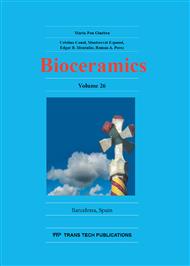p.30
p.36
p.43
p.51
p.57
p.61
p.67
p.73
p.78
NMR Structural Characterization of Mg-Containing Nano-Apatite
Abstract:
Nanometer scale Ca-deficient hydroxyapatite (nanoapatite) is a potential candidate as artificial bone substitute materials owing to its similarity to the bone with respect to composition, morphology and osteoclastic degradation or adsorbent materials for blood purification therapy to remove pathogenic substances. The initial biodegradation behaviors, the initial cell-material interaction and the protein adsorption properties of nanoapatite must depend on the microstructure. The purpose of this study is the preparation of nanoapatite particles and their structural characterization by using X-ray diffraction (XRD) and solid-state NMR spectroscopy. The nanoapatite particles were prepared by precipitation processing method, and the effects of magnesium ions on the precipitation of calcium phosphate were examined, because Mg ions are well-known to play a role of inhibition of crystal growth. The addition of Mg ions led to the precipitation of nanometer scale Ca-deficient apatite crystals having 1.33-1.63 of the molar ratio (Mg+Ca)/P. NMR analyses showed that the microstructure of Mg•HAp particles can be explained by a crystalline HAp core covered with a thin amorphous hydrated calcium phosphate layer.
Info:
Periodical:
Pages:
57-60
Citation:
Online since:
November 2014
Keywords:
Price:
Сopyright:
© 2015 Trans Tech Publications Ltd. All Rights Reserved
Share:
Citation:


